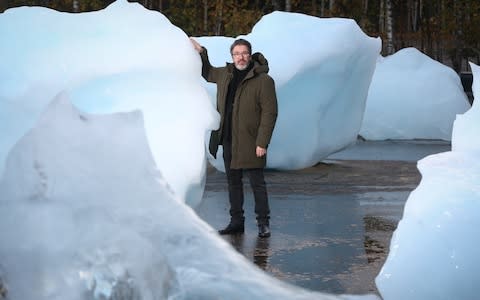Artist Olafur Eliasson installs melting icebergs in the heart of London

Olafur Eliasson, the artist who brought the sun to Tate Modern, has returned with 24 blocks of melting Arctic ice.
Eliasson’s latest installation, Ice Watch, is intended to highlight the urgency of climate change. Another six blocks have been positioned in the City of London, outside the offices of Bloomberg.
If you want to see them, you need to hurry. They will have melted into a puddle by next week.
Eliasson unveiled the work before an audience of bemused City workers, who he hopes will stop to touch - and listen to - the ice, and see the tangible effects of global warming.
“If you have a problem understanding the science and what politicians are talking about, put your hand out,” he said.

The blocks “are individual, they are like beings, they whisper to you. If you put your ear to them, you can hear the air bubbles. And that air is fresh and clean - it has half the CO2 of the air outside."
The ice was winched out of the the Nuup Kangerlua fjord in Greenland, where it had fallen from the ice sheet, and transported to Britain in freezer containers alongside a cargo of fish. From Immingham Docks near Grimsby, the blocks were taken by truck to London and lowered into place by crane.
The blocks weighed between one and six tonnes when they were installed. According to Eliasson and his partner on the project, geologist Minik Rosing, 10,000 blocks of this size melt every second.
“I think everybody at this point thinks about climate change but it remains relatively abstract,” the artist said. “Here the ice is actually real, it’s not something far away in Greenland.
“It’s great [to have the works] at a cultural institution, the Tate, and the financial centre. I’m very excited about the balance. I doubt that the bankers and people in this area come to the Tate, and vice versa. But in both cases it is a public space.”

Tate Modern was the site of Eliasson’s 2002 Turbine Hall installation, The Weather Project, which created the illusion of a vast yellow sun glowing through fog.
The Icelandic-Danish artist, now based in Berlin, was asked about the new project’s carbon footprint and claimed it worked out as the equivalent of 24 people flying to Greenland and back.
As for how long the installation will last: "Saturday, maybe Sunday. If the sun picks up and it gets warmer, it's going to be gone very fast."

 Yahoo News
Yahoo News 
